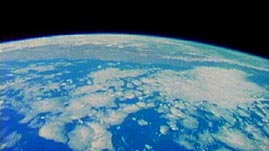Teachers' Domain - Digital Media for the Classroom and Professional Development
User: Preview

Source: Interactive NOVA: "Earth"
Great inventions sometimes have unintended consequences. Such was the case with a non-toxic, non-reactive gas produced in the 1920s. This video segment adapted from Interactive NOVA describes the discovery that led to the fall of chlorofluorocarbons, once heralded as miracle compounds and now scientifically documented as destroyers of an atmospheric gas critical to life on Earth.
A Hole in the Sky (Spanish audio) (Video)
The "miracle compound" that Ohio chemist Thomas Midgley, Jr. unveiled in 1928 was prized for its chemical stability. A combination of chlorine, fluorine, and carbon atoms, Midgley's chlorofluorocarbon (CFC) molecule remained intact and unreactive under a wide variety of conditions. This stability made the compound useful in a range of products, including refrigerants and aerosol propellants. Chemical stability also meant that CFC molecules would persist in the atmosphere for a long time after they had been used, a fact no one worried much about at the time.
After being released into the air, CFCs ascend through the troposphere, the atmospheric layer nearest the ground. Over a period of months or years, they may rise through the troposphere to the stratosphere, approximately 10 to 17 kilometers (6 to 11 miles) above Earth's surface. The stratosphere is home to 90 percent of a relatively rare but critical gas that makes Earth inhabitable for the great diversity of terrestrial life forms: ozone. Composed of three oxygen atoms, rather than a pair of atoms as is the case with the oxygen we breathe, ozone is important for its ability to absorb harmful ultraviolet (UV) radiation from the Sun. When a photon of UV light strikes an ozone molecule, the energy splits the molecule into one two-atom oxygen molecule and one free oxygen atom and transforms the UV energy into heat. In this way, stratospheric ozone absorbs up to 98 percent of the Sun's UV radiation before it can harm organisms on Earth's surface.
CFCs also encounter ultraviolet radiation in the stratosphere, and they too are broken apart by these encounters. Chlorine atoms released when CFC molecules are destroyed are highly reactive with other stratospheric gases, including ozone. In quick order, a chlorine atom can pull a single oxygen atom away from an ozone molecule, release it to another single oxygen atom and move on to participate in countless reactions of this type. Scientists estimate that a single chlorine atom will, on average, destroy more than 100,000 ozone molecules before it becomes bound in a stable molecule again.
Recognizing the negative effect that CFCs and other ozone-depleting compounds have on the ozone layer, more than a hundred nations have signed several resolutions since 1987 in an attempt to ultimately phase out the world's use of these gases. Thanks to international cooperation and the continued adherence to global agreements concerning these compounds, some experts estimate that the ozone layer will recover by the middle of the 21st Century.
 Loading Standards
Loading Standards Teachers' Domain is proud to be a Pathways portal to the National Science Digital Library.
Teachers' Domain is proud to be a Pathways portal to the National Science Digital Library.
